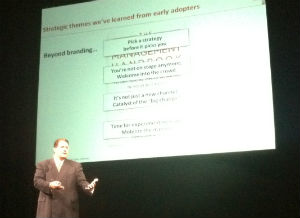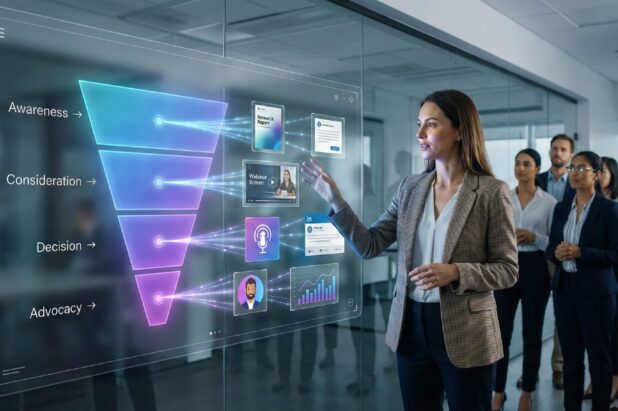 As companies seek to understand where and how social media fits, one of the key questions asked is: How can you move beyond branding with social media and directly affect business outcomes?
As companies seek to understand where and how social media fits, one of the key questions asked is: How can you move beyond branding with social media and directly affect business outcomes?
At Dreamforce this week, Robert Wollan – Global Managing Partner for Accenture CRM, attempted to answer that question with his presentation: “Making $ocial Media Pay – With (Really) Fast Followers.
Most C-level execs are finding that traditional channels are not delivering the results that they had in the past. At the same time, they’re trying to capture new growth potential through disruptive forces and emerging channels like social. Conversations need to happen about social in the boardroom and at C-levels in order to affect real change in the organization.
 Successful social leaders get past the hype of individual social tools and focus more on the specific social media behaviors that can lead to revenue growth. What are the behaviors inside and outside the organization that can be capitalized on to generate revenue? Social media is a catalyst for change to better go after digital consumers.
Successful social leaders get past the hype of individual social tools and focus more on the specific social media behaviors that can lead to revenue growth. What are the behaviors inside and outside the organization that can be capitalized on to generate revenue? Social media is a catalyst for change to better go after digital consumers.
Key considerations: speed, mobile, real-time, behaviors.
1. Pick a strategy before it picks you. Most companies get into social media
- Uh, Oh strategy. A viral event from a customer or employee
- It’s too big not to be there strategy
- Response to a competitor
How many of our customers are social media active? Where? What do they do? How can we leverage social participation to affect business outcomes?
2. You’re not on stage anymore. Welcome into the crowd. Marketing and sales needs to adjust speed and be more agile.
3. Social Media is not just a new channel. It’s not like commerce where we have a new place to sell. What’s going to change if we become a successful social enterprise? What needs to change in the organization in order for the company to be successful? Social media is a catalyst for organizational change.
4. The time for experimentation is up. It’s time to mobilize the masses. Social media isn’t just about marketing, it’s about integrating social media into the way the organization operates and collaborates. HR needs to be involved from day one.
DNA of the Really Fast Follower:
It’s a convoluted path from the Enterprise to the Consumer. Early examples of social media focused on certain types of businesses, so it’s important to understand what part of the DNA chain makes the most sense to optimize through social media.
- BtoB relationships
- BtoC relationships
- PtoP relationships
Figure out where social media can make a difference at the end of the day.
Three places to optimize for social:
- Create lead opportunities with social
- Speed to leads and better matching leads.
- Cutting costs, being more efficient
A Sales Community that brings B2B sales teams together includes:
- Sales Best Practices
- Sales Training
- Market Intelligence
- Process Support
- Sales Planning
- Sales Incentives
- Sales and Marketing Materials
With Business to Consumer, the opportunity that stands out is “speed to consumer” through fast innovation and knowledge arbitrage. (Lee: You gotta love the vernacular of consultancies)
To get going with the social web, the different levels of engagement are typically:
- Listen (Learn & Adapt)
- Engage (Build your own network)
- Optimize (Drive Innovation)
Listening Examples:
USAA embedded social listening into operational execution. They don’t look at social media data as another set of reports, but as central. Social data is the essence of how they understand their customers. Those social insights are incorporated into how they operate – it’s part of the culture.
Samsung uses social listening across the ecosystem. They tap into social in order to innovate by understand what their customers want. What is learned in social media affects operational choices made. Social isn’t just treated as a special project.
Engagement Examples:
The Commonwealth Bank of Australia launched a campaign to grow underserved market segments. The effect of the campaign was amplified through social media, which was directed towards female entreprenuers.
Dell has engaged by identifying and mobilizing influencers across multiple functions. They’ve launched the listening center. Wet Seal is an online retailer focused on reaching young women that’s redefining the shopping experience. They create engagement amongst customers by providing the ability to assemble outfits and virtually interact with the product.
Optimize Example:
Best Buy decided to launch a tool to extend their tech expertise beyond stores and the website through Twelpforce on Twitter. Best Buy engagement with customers and employees helps to solve problems. If you have a question, tweet @twelpforce and you’ll get an answer from one of 12,000 employees competing to answer the fastest and best. In the first year, Twelpforce has driven down customer complaints by 20%.
Key benefits of the Twelpforce model include speed and connecting questions with the best people to answer, which isn’t practical in a call center situation. Service is a differentiator for Best Buy over other electronics retailers.
The things to get right for really fast followers:
- Act now. The time for experimentation is behind us
- Embrace social media with digital and mobility. Don’t isolate it.
- Make sure everyone across the enterprise is aligned to an outcome.
- Untangle the technology complexity and address questions of how social media will be applied to the business
- Empower the front line people of your organization
- Social media needs to be a cC-Suite imperative. Don’t delegate it down in the organization.
I think some of the important takeaways from this presentation is a focus on understanding behaviors (vs starting with social applications) and how they can impact business outcomes. Also, there’s no time to wait, businesses need to figure out where social fits in their organization, NOW. The rate of change and social adoption by consumers, buyers and the competition is happening so fast, that coming into the world of social enterprise late, could put a company at an uncomfortable disadvantage.


